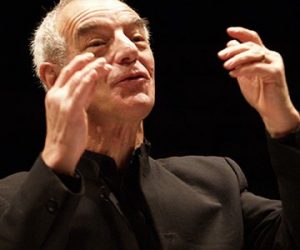Bach Collegium San Diego Offers a Worthy Tribute to Its Namesake
Having covered Shaham’s profound traversal of the solo repertory on Friday, hearing the Bach Collegium’s 16 accomplished period players on Saturday—under the sleek leadership of guest conductor Nicholas Kraemer—proved the perfect complement. Although Bach Collegium San Diego typically offers larger choral works—even the occasional opera—this program was exclusively instrumental.
Kraemer conducted standing at the harpsichord, and his direction was nonpareil: clean and steafastly
propulsive, evoking a bouyant pulse regardless of tempo. His sparkling harpsichord realizations sounded bright and full. A British conductor who started his career as a harpsichordist, Kraemer leads period ensembles in England and the U.S. and used up some of this “15 minutes of fame” as the Baroque Music Director for the film The Madness of King George. For those wondering how one could play the harpsichord and conduct simultaneously, the conventions of music from this period require the cellos and contrabass to double the bass line the harpsichord plays, so lifting the left hand to cue the other players clustered around the harpsichord does not mean the bass line drops out. The low strings always have it covered.Bach’s Brandenburg Concerto No. 3, BWV 1048, indulged the ensemble’s warm, buzzy string sonority (something that only gut strings can create). Kraemer brought out the opening movement’s drama, supplied a charming harpsichord improvisation as the second movement (the composer left only two chords for this movement in his score), and drove the finale at breakneck speed for an exciting conclusion.
The Fouth Brandenburg, BWV 1049, featured the solo group of Concertmaster Pierre Joubert and the two virtuoso recorder players Kathryn Montoya and MaryAnn Shore. This trio’s effervescent, athletic lead gave this work the panache it deserves. I particularly enjoyed the vocal phrasing the recorders gave their “sighing” motifs in the slow movement, that trademark Baroque pathos that Bach employed with such skill.
With bassoonist Sally Jackson and Shore and Montoya on oboes, this superlative wind trio made Bach’s C Major Orchestral Suite, BWV 1066, shimmer with French grandeur, something Bach was able to conjure with even more power than those composers born to the style. Kraemer and crew filled every dance movement in the Suite with ingratiating phrasing that made this audience member want to join in the dance, although the appropriate steps to a Forlana are known only to serious dance historians.
Between the two Brandenbugs, Kraemer offered Henry Purcell’s Fantasia Upon a Ground, Z. 731, a rarely played but compelling contrapuntal exercise for strings. Although the bass line (the “ground”) is the same one Pachelbel used for his now ubiquitous Canon in D, the Fantasia has more in common with the inventive variations of Bach’s celebrated Chaconne from the D Minor Partita for Unaccompanied Violin.
The program also included well-tailored accounts of G. F. Handel’s Concerto Grosso, Op. 3 No. 2, and a Concerto for Strings No. 8 (“La Pazzia”) by Francesco Durante, a Neapolitan composer, almost an exact contemporary of Handel. I would suggest that the breezy facility of Handel’s Italianate instrumental music is the reason we treasure instead his operas.
Bach Collegium_San Diego program


![Nicholas Kraemer [photo (c) Jim Steere]](http://www.sandiegostory.com/wp-content/uploads/2015/03/N_Kraemer_JimSteere-300x240.jpg)